"Mason, the school is moving, eleven to one. There you can see the push."

"I'm on them."
"Nice Cast!"
"Fish-on", yells Jamie.
"I've got one too," says Jerad as he high sticks to avoid a line cross over.
Can you just imagine the excitement of a triple hook up? Which fish would you
follow? The boys were excited. Adrenalin was at an all time high. Yet the
casts were deliberately and patiently slow. Only forearms moved slightly from
that "windshield wiper" technique I'd recently taught them. The casting was
smooth with little or no ripples in the line. There was no loss of energy in
their casts.
"Mason."
"What?"
"How many is that?"
"My fifth so far, Jerad."
"I've just hit my seventh, and working on an eighth."
"Jerad, there's a trout in that small white hole, can you reach him. It's a long,
long cast. Maybe 90 feet."
"No problem, Jamie. I can cast 110 feet."
And, he can!
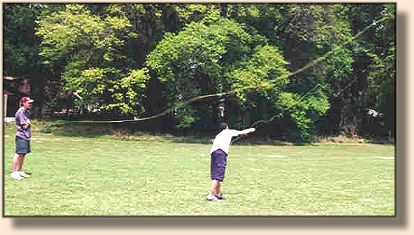
How would you like to be in their position? Three IGFA Junior Anglers going
to school, casting to redfish. When was the last time you effortlessly cast 80
or 90 feet?
Did you count them? Would you believe 25 redfish and 7 trout in four
hours? I don't have many clients that can do that. But then again these
young anglers put in the time to become accurate long distance casters
by watching their line and double hauling.
Their keen eyes scanned the green 'water' looking for the signs of moving fish.
In this case, the school of fish was a white area marked with lime in the grass.
Many schools, or single fish, were marked along the playground's outside edge.
Each target had a specific clock position. A large shape showed a big school
of fish. Land your line there and you got one point for a 60-foot cast. A smaller
white area would net you five points for a 75-foot cast. A smaller area was a
tough Spotted Sea Trout target about 90 feet away. It was the size of a
10-gallon bucket, a ten-point tag. I never figured they would get this creative
when I suggested they put targets in the field. Jerad is given credit for this
imaginative way to hone their casting skills.
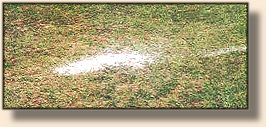
The scene continued with line hissing in the air. Jamie wet-hauled his hook-less,
practice fly out of the grass. The cast was a mastery of skill. He watched as
the line started its way back. He felt the rod load, then double-hauled as he
started the forward cast. Just as effortless as the back cast, his forward cast
took the fly out to settle in front of the school.
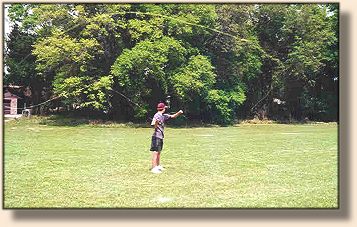
"Way to go, Jamie," yells Mason.
The boys took turns calling out positions on the clock. Jerad stood on his bucket
poling platform and pointed to the moving fish. At one point he said, "I'm a redfish,
someone lead me."
"Mason, three-o'clock, 60 feet."
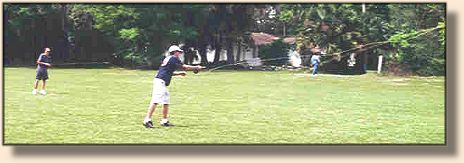
Mason started a haul to his back cast. He watched the tip and followed the line
with his left hand. Then Mason did another haul (the double-haul) and released
his line. Line sang through the guides. He could see that the line would
overshoot his target so he pinched the line running through his hand. The
line set down so that just the tippet landed softly just in front of the school
of redfish. Now he was ready for the fly to settle and start his first strip.
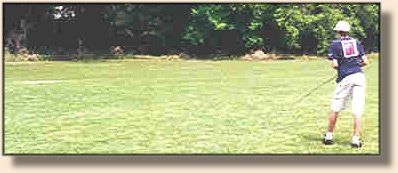
Jerad's mom stepped into the field, "How's the fishing, boys?"
"Really good, Mom. We caught 25 reds and 7 trout." All smiles, they started
to break down the rods and head off the field towards home for lunch.
"I was watching you, Mason. You are getting really good."
"Thanks, Mrs. Winchell."
That's all you need; one back cast and one forward cast, hauling in both directions.
Practice pays off. Let the rod do the work.
Catch/Release: it's the right thing to do.
~ Doug.
About Doug:
Doug is a USCG Licensed Captain and fly-fishing guide from New Smyrna Beach, FL
a member of CCA, FFF, AFF, APCA, FOWA, the Action Craft Saltwater Team,
and the Orvis and Redington Pro-Guide Program. He can be reached at 386-679-5814.
|













